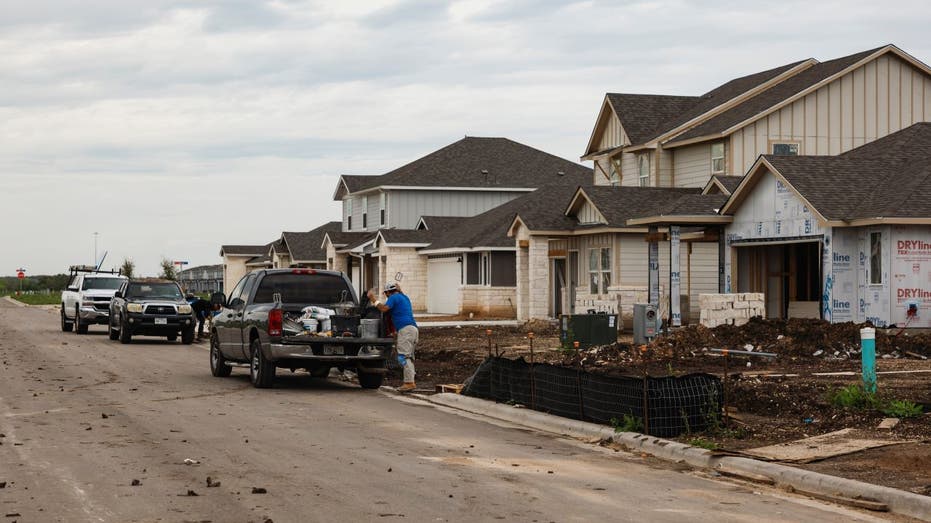Tariffs recently announced by President Donald Trump causing worry among U.S. homebuilders.
Those concerns, which FOX Business correspondent Gerri Willis reported on Wednesday, come after the president has pursued a slew of tariffs in recent weeks, including moving to reinstate a 25% tariff on steel imports and lift the levy on aluminum imports back to 25%.
Trump also previously announced 24% tariffs on imports from Canada and Mexico and a 10% tariff on imports from China; however, the levies targeting Canada and Mexico have been paused until at least early March.
On Tuesday, the National Association of Home Builders/Wells Fargo Housing Market Index for single-family housing showed a five-point drop in builder confidence month-over-month, hitting 42 in February.
PRESIDENT TRUMP LOOKS TO BRING MANUFACTURING BACK TO US WITH TARIFFS
That, according to the NAHB, was below the index’s 50-point benchmark for positive sentiment and the “lowest level” it has reached in five months.
Homebuilder sentiment for current sales conditions came in at 46 for February, marking a four-point drop from the prior month. Other data from the HMI indicated they feel negatively about prospects for sales in the coming six months, with their expectations for that also hitting 46.
“While builders hold out hope for pro-development policies, particularly for regulatory reform, policy uncertainty and cost factors created a reset for 2025 expectations in the most recent HMI. Uncertainty on the tariff front helped push builders’ expectations for future sales volume down to the lowest level since December 2023,” NAHB Chairman Carl Harris said in a statement.

Applications to build new privately-owned housing came in at a seasonally adjusted rate of 1.48 million in January, marking a 0.1% decline from the prior month, according to new U.S. Census Bureau data released Wednesday.
Meanwhile, housing starts dropped 9.8% from December to a seasonally adjusted annual rate of 1.37 million. For single-family housing in particular, the rate was 993,000 in January, down 8.4% from December.
Trump’s steel and aluminum tariffs are slated to come into force in mid-March.
When the White House unveiled them last week, the NAHB said they are “totally counter” to efforts to improve housing affordability “by raising home building costs, deterring new development and frustrating efforts to rebuild in the wake of natural disasters.” It argued homebuyers will face steeper prices because of them.
The NAHB raised similar concerns that the tariffs on Canadian and Mexican imports could also “increase the cost of construction and discourage new development” after Trump announced those. It has called for exemptions for construction materials from those levies.
Building materials such as softwood lumber, gypsum, steel and aluminum could see cost increases because of the tariffs, according to the NAHB. Home appliances could also be affected.
Willis reported “economists say there are signs that the market is becoming friendlier to buyers.”
TRUMP’S TREASURY SECRETARY SHUTS DOWN ANY TARIFF CONCERNS, PRAISES ‘FRICTIONLESS GLOBAL TRADE’
“According to Realtor.com’s January data, home price reductions were 15.6% of the market. That is up almost a whole percentage point from a year ago,” Realtor.com Senior Economist Daniella Hale told FOX Business. “It is a sign that more sellers are being more flexible on pricing compared to a year ago.”
Realtor.com pegged the median listing price for homes at $400,500 nationwide, marking a 2.2% drop from the same month last year. That figure remains 38.4% higher than homes in January 2019, according to its report.
The 30-year fixed-rate mortgage rate reached 6.87% on average the week of Feb. 13, according to Freddie Mac. That marked a 0.02 percentage point drop from the prior week.
Mortgage rates will hit 6.5% by the end of 2025, the Fannie Mae Economic and Strategic Research Group predicted late last month. By the end of 2026, they could be 6.3%.
Read the full article here


